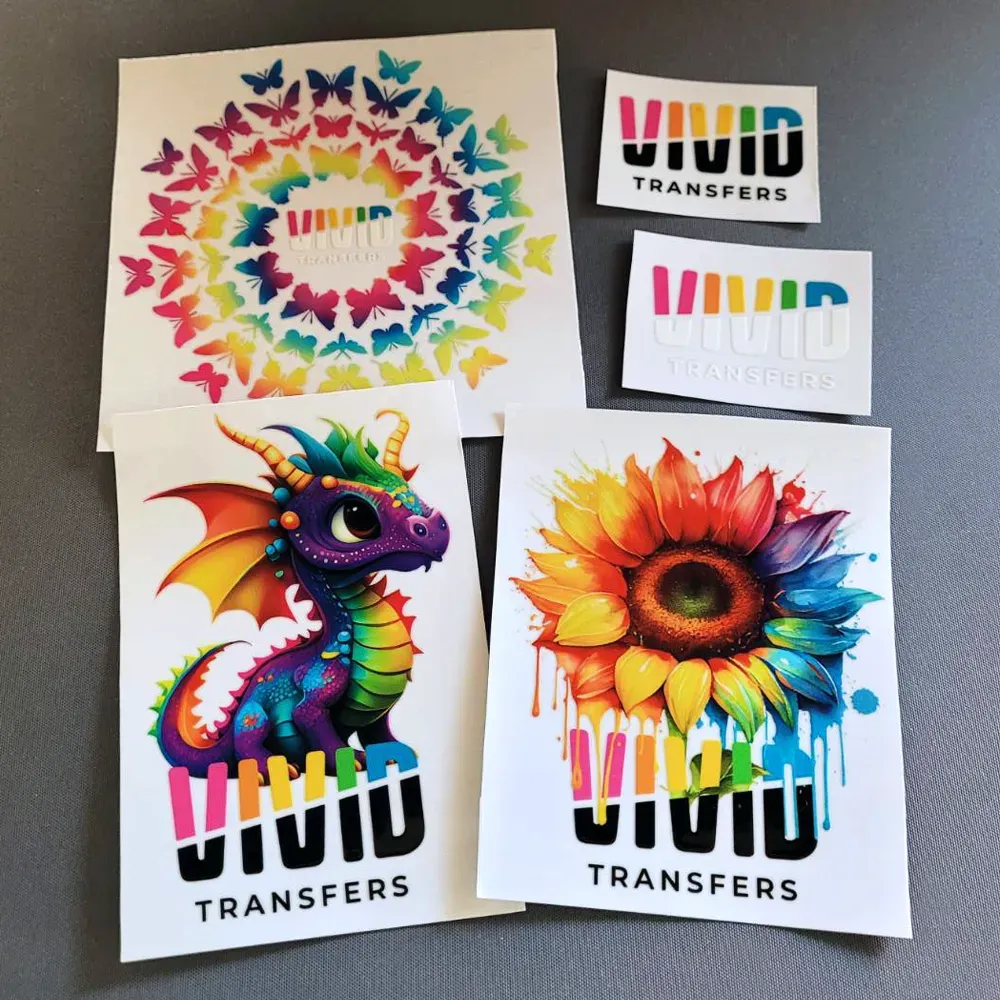In the realm of contemporary printing technology, **UV DTF transfers** have rapidly gained traction as a superior method for producing striking images on a multitude of surfaces. Utilizing cutting-edge UV transfer technology, this technique allows for the direct application of vibrant graphics onto a transfer film, which can be seamlessly adhered to textiles, metals, plastics, and more. The benefits of UV DTF transfers are plentiful, including high durability, exceptional color detail, and speed in production, making it a favored choice among businesses seeking quality and efficiency. This guide will explore the various uses of UV DTF, effective techniques for UV DTF transfers, and the innovations driving its growth in the industry. As we delve deeper, you’ll discover why UV DTF printing is a transformative solution for creative applications across diverse fields.
Embracing the latest in transfer printing technology, direct-to-film UV transfers represent a revolutionary approach to customizing a wide range of products. Unlike traditional methods, this innovative printing process integrates ultraviolet light to cure inks, ensuring that designs maintain their vibrancy and durability over time. The functionality and efficiency of these UV transfer techniques cater to various sectors, enhancing the aesthetics of apparel, promotional materials, and even industrial tools. With a focus on versatility, UV DTF has carved a niche for itself in today’s marketplace, paving the way for personalized designs that stand the test of time. In this comprehensive exploration, we will delve into the array of benefits, practical applications, and the cutting-edge methods employed in the world of UV transfers.
Understanding the Basics of UV DTF Transfers
UV DTF transfers, or Direct to Film transfers, represent a cutting-edge methodology in the printing industry, facilitating the production of brilliant and durable images. By employing ultraviolet (UV) light technology, this process allows prints to be transferred from a specialized film onto a wide range of materials. The primary appeal of UV DTF transfers lies in their capability to deliver high-quality graphics with vivid colors and intricate detailing, catering to diverse applications from textiles to rigid substrates.
Through the unique functionality of UV DTF printing, designs are printed on a transfer film that adheres perfectly to surfaces once cured under UV light. The flexibility of this method permits on-demand production, allowing businesses to meet customer needs quickly while retaining impeccable quality. As a result, UV DTF transfers have carved a niche in both small-scale custom jobs and large manufacturing runs.
The Significant Benefits of Utilizing UV DTF Transfers
The advantages of opting for UV DTF transfers are manifold, with one of the most prominent benefits being their versatility. Businesses can apply UV DTF technology to an array of materials, including fabrics like cotton and polyester, as well as more rigid surfaces like wood and metal. This adaptability enables companies to broaden their offerings, tapping into various markets and ensuring they can meet diverse customer preferences.
In addition to versatility, UV DTF transfers boast superior durability. The cured ink forms a tough barrier against scratches and weather elements, making it suitable for both outdoor and industrial applications. This resilience contributes to longer-lasting branding and personalizations, which is essential in maintaining a polished appearance for promotional products.
Common Applications of UV DTF Transfers in Various Industries
UV DTF transfers have a wide range of applications across multiple industries. One of the most popular uses is in apparel decoration, where custom designs, logos, and patterns are applied to clothing items. Whether for team jerseys, casual wear, or corporate apparel, this method allows for striking graphics that withstand regular wear and laundering.
Additionally, businesses frequently utilize UV DTF transfers to create memorable promotional items such as branded bags, mugs, or pens. This printing technique enables companies to showcase their logo or message with clear, vibrant colors, enhancing brand visibility and recognition among potential customers.
Techniques for Implementing UV DTF Transfers Successfully
To successfully implement UV DTF transfers, a series of essential techniques must be followed. It begins with the preparation phase, where the chosen substrate is thoroughly cleaned to ensure optimal ink adhesion. This step is vital as it directly impacts the longevity and aesthetics of the print.
Following preparation, the printing process uses a specialized UV printer to apply the ink onto the transfer film. This stage often requires layering techniques to achieve the desired color vibrancy, including the strategic use of white ink for varied surface types. Subsequent curing under UV lights facilitates immediate ink set, ensuring a high-quality finish that is ready for transfer.
Innovations Shaping the Future of UV DTF Technology
The UV DTF printing landscape is not static; it is undergoing rapid advancements that enhance both user experience and output quality. Manufacturers are introducing more compact and user-friendly printers to streamline operations, allowing businesses of all sizes to utilize this technology without extensive training or investment.
Moreover, ongoing improvements to ink formulations are leading to greater durability and color reproduction accuracy in UV DTF transfers. These developments pave the way for more sophisticated products, marking an exciting phase for UV transfer technology, which continues to evolve and meet the dynamic needs of different industries.
Conclusion: The Future of Printing with UV DTF Transfers
In conclusion, UV DTF transfers represent a major advancement in the printing industry, offering a versatile and efficient solution for businesses. The combination of vibrant colors, durability, and adaptability makes this technology an indispensable asset for creating high-quality custom products across multiple applications.
As technology continues to progress, UV DTF transfers are poised to play a crucial role in the future of printing. With their ability to cater to diverse markets—from apparel to promotional items and beyond—it’s clear that those seeking innovative printing solutions should consider integrating UV DTF technology into their processes.
Frequently Asked Questions
What are the main benefits of UV DTF transfers?
UV DTF transfers offer numerous benefits including versatile applications on various materials, high durability that withstands elements, vibrant color reproduction for intricate designs, and speed and efficiency in production. These advantages make UV DTF transfers an attractive choice for both businesses and consumers.
How are UV DTF transfers used in apparel decoration?
UV DTF transfers are widely used for apparel decoration, allowing custom designs and logos to be applied to clothing items like t-shirts, jackets, and jerseys. They provide high-quality prints that are vibrant and durable, making them ideal for fashion and promotional purposes.
What techniques are involved in the UV DTF transfer process?
The UV DTF transfer process involves several key techniques: preparation of the substrate for ink adhesion, printing with a specialized UV printer, curing the ink with UV light, transferring the film to the target surface using heat and pressure, and optional post-processing like laminating for additional durability.
Can UV DTF transfers be used for promotional items?
Absolutely! UV DTF transfers are perfect for creating custom promotional items such as bags, pens, and mugs. Their flexibility and ability to produce high-quality, colorful designs make them an effective means for businesses to showcase their branding.
Why is UV DTF printing considered efficient?
UV DTF printing is considered efficient due to its fast production times and on-demand printing capabilities. This reduces waste and turnaround times, allowing businesses to fulfill custom orders quickly without compromising on quality.
What makes UV DTF transfers suitable for industrial applications?
UV DTF transfers are ideal for industrial applications because of their durability and resistance to wear and weather conditions. They can be used to create long-lasting stickers, labels, and branding on tools and machinery, ensuring logos remain intact in tough environments.
| Key Points | Details |
|---|---|
| Introduction | UV DTF transfers are a modern printing technique using ultraviolet light for high-quality images on various surfaces. |
| Definition | A process printing vibrant graphics on a special film with UV ink, ensuring durability and detail. |
| Benefits | Versatile application, high durability, vibrant colors, and efficient production. |
| Uses | Applicable for apparel, promotional items, home decor, and industrial applications. |
| Techniques | Preparation, printing, curing, transfer, and post-processing are essential for successful results. |
| Recent Developments | Advancements in technology are leading to better printers and ink formulations. |
Summary
UV DTF transfers are a groundbreaking method in the printing industry known for their adaptability and exceptional quality. This innovative approach allows for the creation of detailed and vibrant prints on various surfaces, from clothing to hard materials. The method combines durability with aesthetic appeal, making it ideal for businesses aiming to enhance their branding through customized merchandise. As technology progresses, the efficiency and capabilities surrounding UV DTF transfers continue to improve, solidifying their place in the future of personalized printing solutions.



